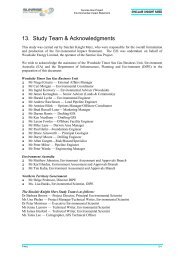Appendix D Terrestrial and Aquatic Biodiversity - Environment ...
Appendix D Terrestrial and Aquatic Biodiversity - Environment ...
Appendix D Terrestrial and Aquatic Biodiversity - Environment ...
You also want an ePaper? Increase the reach of your titles
YUMPU automatically turns print PDFs into web optimized ePapers that Google loves.
5.4.2 Fauna Survey Results<br />
The surveys recorded a total of 151 native fauna species, comprising of 15 amphibians, 29 reptiles, 92 birds,<br />
<strong>and</strong> 20 mammals. Four introduced species were identified. The majority of species were identified through<br />
trapping, active search techniques, <strong>and</strong> incidental observations. Species lists are provided in the sections<br />
below, <strong>and</strong> site data is provided in <strong>Appendix</strong> D-3. Summary descriptions by faunal group for each are<br />
provided below.<br />
The majority of species recorded during the survey are common <strong>and</strong> generally widespread throughout similar<br />
habitat in the region. One Threatened species (as per the TPWC Act) was identified during the survey –<br />
Mertens’ Water Monitor (Varanus mertensi). No species listed as threatened under the EPBC Act were<br />
identified, however two listed migratory species (both birds) <strong>and</strong> 21 listed marine species (20 birds <strong>and</strong> 1<br />
reptile) were recorded.<br />
Amphibians<br />
A total of 15 amphibians was recorded from the surveys, mainly from pit traps <strong>and</strong> active searches (<strong>Appendix</strong><br />
D-3). Most were recorded around freshwater swamps, creeks <strong>and</strong> pools in the area. Amphibians from the<br />
genus Uperoleia were trapped but could not be identified to species level without a reference call. The most<br />
prolific species were those preferring grassl<strong>and</strong>s <strong>and</strong> seasonally inundated habitats. Three species of<br />
amphibians were recorded once only; three others twice only.<br />
Reptiles<br />
• No threatened species were identified.<br />
• Three Data Deficient species were identified – Litoria australis, Litoria bicolor, <strong>and</strong> Opisthodon<br />
ornatus. These species are common <strong>and</strong> widespread throughout this region, <strong>and</strong> also the across<br />
northern Australia.<br />
• One Introduced species was identified, Cane Toad (Chaunus marinus), which was identified at<br />
each location along the haul road.<br />
• The remaining species (including the unidentified Uperoleia species) are all listed as Least<br />
Concern.<br />
A total of 29 reptiles was recorded from the survey, mainly from pit traps, funnel traps <strong>and</strong> active searches<br />
(<strong>Appendix</strong> D-3). Geckoes <strong>and</strong> skinks were the best represented families, as well as the dragon species<br />
Diporiphora magna. Few snakes were recorded <strong>and</strong> nine species of reptiles were recorded only once. The<br />
Rosie site contained five species not found anywhere else.<br />
Birds<br />
• One threatened species, Mertens’ Water Monitor (Varanus mertensi), which is listed as Vulnerable<br />
was identified at both Cox <strong>and</strong> Rosie sites in <strong>and</strong> along creeks.<br />
• One Data Deficient species was recorded, Cryptoblepharus australis, a common <strong>and</strong> widespread<br />
skink in suitable habitat throughout northern Australia.<br />
• The remaining species are all listed as Least Concern.<br />
• One listed marine species – Freshwater Crocodile (Crocodylus johnstoni) – was recorded.<br />
• No introduced reptile species were identified.<br />
A total of 92 native bird species from 37 families was identified during the survey (<strong>Appendix</strong> D-3). Birds were<br />
most active in the hours of dawn <strong>and</strong> dusk, <strong>and</strong> bird count numbers were maximized by varying the sites<br />
visited at these times. The Limmen <strong>and</strong> Towns (Lower) sites were the driest <strong>and</strong> contained the least avian<br />
Client: Western Desert Resources Ltd Page 105 of 150<br />
Doc No. DW120004-C0302-EIA-R-0036<br />
Doc Title: <strong>Appendix</strong> D – <strong>Terrestrial</strong> <strong>Biodiversity</strong> Technical Report



